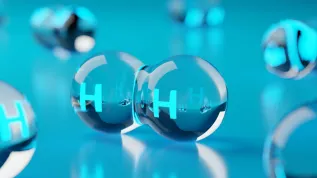
Controlled inhibition or acceleration of catalytic transformations is highly desirable in many processes, including industrial applications. Therefore, many efforts are being made across the world to provide systems enabling rapid and efficient control over catalysis. In a new study, researchers from the Institute of Physical Chemistry of the Polish Academy of Sciences in Poland have introduced an innovative concept for control over chemical reactions during catalytic processes.
Nature is amazing. It has developed in living organisms the ability to regulate complex biochemical processes with remarkable efficiency. Enzymes, natural catalysts, play a pivotal role in this regulation, ensuring fulfillment of various physiological needs throughout a cell’s lifespan. Furthermore, specific organic molecules and metal ions bind to enzymes, modulating their catalytic activity either upward or downward. This interplay of activators and inhibitors harmoniously upholds order in a cascade of chemical processes within cells.
Enzymatic catalysis continually inspires scientists to mimic nature to control various processes in many fields, from small laboratory scale to large industrial manufacturing of many chemical compounds. However, despite the high efficacy of synthetic catalysts, alternating between acceleration and inhibition does not stop fully them from working or is limited to the use of additional chemicals. This limitation becomes especially critical in managing simultaneous and sequential processes, where unwanted parallel reactions may persist despite of attempts at modulation. Consequently, many research efforts are underway on methods to control complex transformations in efficient and environmentally friendly manner, reducing the use of additional chemicals, with a particular focus on alternating the start and stop of selected reactions. Is it possible? A new concept described in the journal "ACS Catalysis" sheds clear light on this question.
A new approach proposed by researchers at the Institute of Physical Chemistry of the Polish Academy of Sciences (IPC PAS), led by Prof. Volodymyr Sashuk, has demonstrated easy control over catalytic processes using light, which could be an alternative to chemical regulation typical of enzymes. Based on the proposed concept, it would be possible to selectively slow down or speed up chemical reactions in a fully controlled manner without degrading the catalyst used itself. How it works?
“We demonstrate that catalysis can be controlled by hiding the catalyst within an organic monolayer that envelopes the surface of most inorganic nanoparticles. Thanks to that, complete suppression of the catalytic activity can be achieved.” – claims prof. Volodymyr Sashuk.
The researchers focused on switching the ON/OFF reactions using the nanostructured material, with catalysis able to be turned on or off by employing a specific wavelength, acting much like a "light switch." The material was based on gold nanoparticles (Au NPs) of ~3 nm in size decorated on their surface with ruthenium-based organic N-heterocyclic carbene (NHC) complexes via strong Au-S bonding between the AuNPs and thiol ligands. The uniqueness of the proposed material lies in its composition, in which a bulky thiol (PT) creates steric hindrance, whereas an azobenzene-containing thiol (SAT) supports a Hoveyda-Grubbs ruthenium complex, called a precatalyst, which initiates the catalytic process by reacting with the substrate. The designed nanosystem is photosensitive to a specific range of light, allowing the precatalyst to change its position within the organic monolayer and control access to the substrate and catalysis through electromagnetic stimulation.
In the presence of visible light or in the dark, the ruthenium-based precatalyst is exposed to the solution, initiating and sustaining the metathesis reaction. Conversely, when the system is subjected to ultraviolet irradiation, the azo ligand undergoes isomerization, acting like a "push-button" to prevent precatalyst activation. This is facilitated by a material design in which phenyl rings of PT ligands obstruct access to the precatalyst concealing it from the solution and effectively inhibiting the catalytic process. The feasibility of this mechanism is supported by theoretical simulations conducted by scientists from the University of Trieste, Italy.
Prof. Paola Posocco further explains, “Our computations demonstrated that the gold nanoparticle surface coated with phenyl moieties is better protected from incoming molecules than that containing only aliphatic chains. Clearly, this translates to the observed catalyst shutdown.”
The proposed method allows for rapid and highly efficient catalyst deactivation without the use of additional chemicals, and enables control of reaction rate. The researchers believe that their unconventional approach to photoinduced manipulation of the position of precatalyst in the proposed material will help provide many functional catalysts that will find applications in various fields, particularly in the realm of enhancing chemical selectivity. At the same time, they stress the role of interdisciplinarity during the research.
Source: https://ichf.edu.pl/en/press/the-process-wants-go-the-light-switch-says-no
kap/













